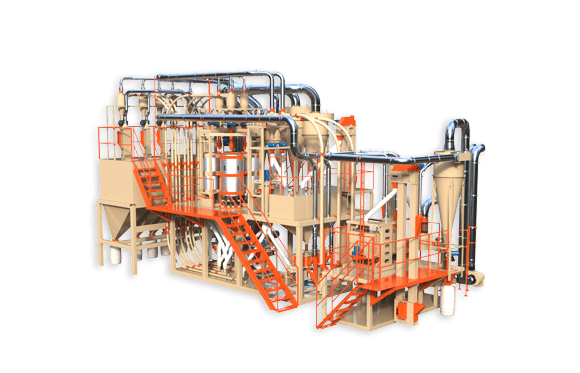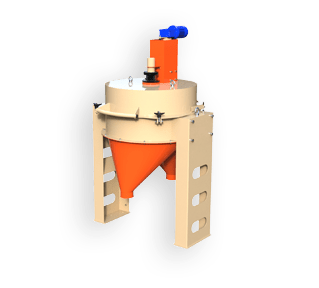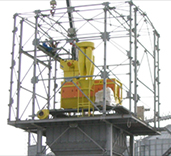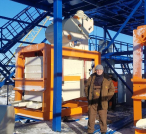Dremlyuk Hryhoriy Kupriyanovych, Doctor of Science and Engineering,
Chief Research Associate of the Breeding and Genetic Institute of the Ukrainian Academy of Sciences (Odesa);
Topal Ivan Aleksandrovych,
chief agronomist of the Tarutyn district of the Odesa region;
engineer for providing agricultural equipment at Ukragroprod CJSC (Odessa).
Almost every agronomist in the south of Ukraine knows about soriz as an agricultural crop with high potential. In addition to the significant yield and value of grain and green mass, sorize does not clog fields, cleans them of weeds, increases the biological activity of the soil, reduces the chemical load on the land, and can be a good precursor for winter barley and spring cereals. Therefore, more and more farms are trying to include this very interesting and useful culture in their field crop rotation. However, not every agronomist has sufficient experience in growing soriza. And only a few specialists, and even with the direct support of scientists, managed to obtain a grain harvest at the level of 40-45 t/ha in the very unfavorable conditions of 1999. What prevents the realization of the high potential yield of corn due to its genetic characteristics?
Corn is able to obtain moisture, and with it, nutrients from deep soil layers, which are not available to most cultivated plants. Corn needs 2.0-2.5 times less water to produce a unit of dry matter than corn, sunflower or spring barley.Soryz is able not only to protect itself from weeds, but also to clear fields of them. But this all applies, unfortunately, to already developed plants, when the struggle for obtaining seedlings and their life will be behind us. And in order to obtain and preserve good seedlings, which is the most important guarantee of a bountiful harvest for soriza, it is not enough to know the main features, it is necessary to be able to take into account all the biological subtleties of this culture.
As a small-grained and heat-loving culture, soriz cannot withstand deep wrapping of seeds and early sowing periods in unheated soil. Therefore, in order to ensure the necessary depth and uniformity of wrapping, special attention should be paid to the selection of the field and soil preparation, and in order to avoid damage to the seedlings by spring frosts and cold weather, the sowing date is set mainly for the first decade of May. On the other hand, sorizo grain has a high vitrification and hardness, but precisely because of these excellent technological properties, it requires an increased amount of moisture throughout the germination period. An important feature of sorizia is the slow development of its stem in the initial period of growth. At first, the plants take root intensively to withstand the summer heat and later overcome the weeds, but in the initial period they need to be protected. That is why when preparing for sowing, one should not take care of the cleanliness of the field. However, it was successful to choose a field, prepare high-quality soil, destroy weeds, sow, and at the same time provide enough moisture for the seedlings of the soriza – it is not an easy task, especially in the south of Ukraine.In this article, we will briefly give the main practical recommendations, which, when applied, will allow you to get guaranteed good soriza plants even in the rain and to take care of them effectively. These recommendations are fragments of the agrotechnology of rice cultivation, which was developed by scientists of the breeding and genetics institute, tested and successfully used by JSC “Ukragroprod” (Odesa) together with a number of agricultural enterprises of the Odesa region.
It is advisable to choose a square-shaped field for sowing corn, which will ensure the possibility of high-quality carrying out of all technological operations. Plowing should be done in autumn, spring plowing or shallow disking is not allowed. The best predecessors are winter ears of corn, beets, and vegetable crops. As predecessors, sudanka, silage and grape sorghum, as well as corn and sunflower are not allowed, when their harvest residues are shallowly hidden. It is desirable to perform a maximum of soil preparation operations in the fall. It is especially unacceptable to “comb” the brushwood and mechanically destroy wild plants in the spring. The fight against cereal weeds should be carried out by applying a soil herbicide, for example Duala at the rate of 1.5-2.0 kg/ha. Thus, the number of spring cultivations can be reduced to one, a maximum of two, and save moisture, which will be necessary for obtaining seedlings. But it must be remembered that the quality of mechanical preparation of the soil for sowing soriza should meet the requirements of sowing small-seeded crops.
When sowing soriza, it is necessary to ensure uniform covering of seeds to a depth of 5 cm, sowing of 10-12 grains per linear meter, taking into account the energy of germination at a width of 70 or 45 cm between rows. For the implementation of these tasks, it is best to use pre-prepared vegetable or combined seed drills. Their disc coulters are equipped with flanges and special self-made loops for wrapping, and the dosing mechanism is adjusted to sow the necessary amount of grains, which is approximately 10-15 kg/ha of conditioned seeds with the recommended width of the rows.The use of other types of domestic seed drills is not recommended, as some of them (beet seed drills) crush the soryza seed, others (SUPN-8) – excessively immerse it in the soil, etc. As an exception, it is possible to use a planter of the SPCH-6 type, but for it it is necessary to make special sowing discs with holes with a diameter of 1.5-1.8 mm with the number of holes 30-36 pieces. It is necessary to be especially careful when using imported types of seed drills, because the sowing of corn with such seed drills is usually not foreseen by their manufacturers, and any “surprises” from untested designs can result in the death of crops.
Although soriz is not affected by soot, but unlike sorghum, tannins are completely absent in its grain, which makes it vulnerable to various microorganisms and pests. Therefore, before sowing, soriza seeds must be poisoned with our favorite modern poisons.
Sorizo should be sown when the soil warms up to a temperature of at least 12 degrees C and the threat of spring frosts or severe colds has passed. However, every day of unjustified delay entails unjustified loss of moisture. It is quite difficult to theoretically predict and determine the optimal period of sowing soriz for each specific year. But our experience makes it possible to easily and unmistakably determine using the following sign: sowing should be started immediately, as soon as the abundant shoots of mice grow on the southern slopes.
When starting sowing, it should be remembered that in order to ensure the uniformity of shallow seed wrapping, the directions of plowing, pre-sowing cultivation and sowing should not be allowed to coincide.In addition to the above, a cultivator of the USMK-5,4 type or Radchenko harrows in a unit with self-made loops for wrapping furrows (if pre-sowing cultivation is planned) and ribbed or universal rollers are necessary for sowing. The organization of sowing is most effective when all the units necessary for sowing work at the same time, that is, the time interval between individual operations should be as minimal as possible, so that the seeder “steps on the heels” of the cultivator, and the rollers – the seeder. In order to increase the rate of growth of seedlings, which is an important measure for their preservation, during sowing, it is advisable to add a little urea at the rate of 50-60 kg/ha.
Taking into account the shallow wrapping of the seeds, when pre-emergence and post-emergence harrowing is necessary, as well as to eliminate compaction of the soil surface from precipitation, only harrows should be used.
In the phase of 2-3 leaves, seedlings are treated with insurance herbicides of the 2,4-D group at the rate of 0.6-0.8 kg/ha of the active substance, preventing the overgrowth of weeds. The optimal plant density is about 100,000 plants per hectare. In order to form the indicated density of the crops in the phase of 4 leaves, they are thinned by harrowing with light harrows at low speeds across the rows. Thinning should not be neglected in any case, because even with row spacings of 70 cm and the number of plants close to 10 plants per linear meter, we risk getting “grass”, which will significantly reduce the yield and grain quality. We note that, in addition to the loss of yield, too sparse sowing also leads to the loss of the ability of soriza plants to suppress weeds and clear the field of the next season’s crops from them. After thinning, it remains to perform 1-2 inter-row cultivation and wait for the crop to ripen. Admittedly, it is very rare, but in some years aphids can attack young soriza plants and cause significant damage. When this pest is detected, it is necessary to treat the crops with preparations of the BI-58 type.
These are the general conditions for success in growing soriza, although every agronomist who is engaged in or will try to engage in this culture due to his youth will certainly add his own subtleties to the above.
By its nature, sorrel is an early-ripening plant, and its physiological maturity occurs 105-110 days after the emergence of seedlings.However, due to the high repairability and frequent August precipitation, its technical ripeness and harvest time fall mainly in September. But we will talk about harvesting together when the time comes.
We want to emphasize once again that sorrel is a plant of high agricultural culture and does not forgive anyone for simplified approaches and unqualified actions. Only those owners who have enough knowledge, skills, inspiration and love for this culture will be fully rewarded with generous harvests.





























